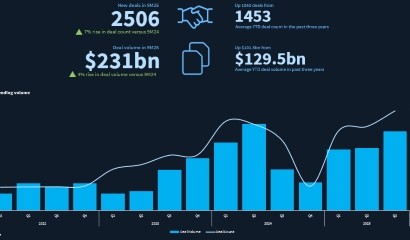Creditors set to take control even as LME spree shows no signs of ending – US Restructuring Outlook
Change of control deals are at the top of restructuring practitioners’ agendas for 2025 following years of efforts by companies to push out maturities and boost liquidity through liability management exercises.
The sometimes-controversial LME maneuvers are hardly going away, though, and are expected to remain the first port of call for distressed companies.
Market participants told Debtwire they expect LME activity to remain elevated as persistently high interest rates, political risk and maturity walls push borrowers to consider restructuring options with creditors and third-party capital providers that allow existing equity investors to preserve their ownership.
“The main drivers of restructurings this year will be some of the previous LMEs from the last year or two that are running out of liquidity,” said Scott Greenberg, global chair of Gibson Dunn’s business restructuring and reorganization practice group. “And since the documents are tightened from the first LME exercise, those companies will likely be forced into a change of control scenario.”
“We’ve started to see full restructurings of post-LME companies that hit subsequent road bumps or don’t realize sufficient deleveraging,” said Damian Schaible, co-head of restructuring at Davis Polk. “In some of these situations, we are seeing creditors and equity holders come together to effectuate out of court changes of control.”
In many cases, LMEs offer short-term solutions to struggling companies and give them a chance to execute a turn around, but advisors warned that if a transaction doesn’t address a business’s wider issues, the LME may start to come back to haunt the company.
“A successful liability management strategy needs to thoughtfully consider all phases, not just the initial exchange,” said Jochen Schmitz, managing director at Greenhill & Co., an affiliate of Japanese bank Mizuho. “Once documents are tightened the playbook for companies narrows meaningfully. As a result, very few second step transactions have been successfully completed to date. While the technology is here to stay, upfront scenario planning will become even more critical in driving value creation.”
Borrowers often add more leverage in an LME in order to boost liquidity, leaving them exposed, according to Joff Mitchell, global co-head of turnaround and restructuring at AlixPartners. “If the economy doesn’t improve or the business performance doesn’t improve, then you’re back to square one, with potentially more leverage and more challenging covenants,” he said.
Even with a limited track record of success, there are few signs that companies and their financial sponsors will skip considering an LME before handing the keys to creditors.
“From the lenders’ perspective, no one wins more than the sponsor in an LME, but lenders still participate to take risk off the table,” said Gibson Dunn’s Greenberg, adding that existing lenders can often step in when there is a risk of a third party to cut a priming deal with the company by taking advantage of loose documents. As a result of the LME where existing creditors participate, documents get tighter to benefit the lenders.
Just how tight can be a point of contention.
There are some post LME documents that are just not tight enough, said a restructuring attorney who spoke on background. For example, while some protections including limiting designation of unrestricted subsidiary are standard, voting thresholds to reelect an unrestricted subsidiary can vary, according to the attorney.
LME fuel
Market participants attribute the LME craze in part to the high cost of in court restructuring and the ample supply of capital ready to be deployed by private credit and opportunistic funds that give companies and sponsors more options in competition with existing creditors.
“This influx of capital has and will continue to assist companies seeking to delay a bankruptcy filing by refinancing their existing loans,” said Shai Schmidt, a partner at Glenn Agre. “At the same time, it can give companies leverage as they negotiate an out-of-court restructuring with existing lenders by threatening—and sometimes executing—a ‘deal away’ with third-party capital providers.”
“There is a very large and active private credit and special situations market that is extremely interested in doing [LME and new money] deals, such as funding into a drop down vehicle,” Schaible of Davis Polk said, adding that private credit funds are increasingly competing with existing lenders of a company to provide capital. Capital from these special situations funds are no longer more expensive than the money coming from the creditors in some situations, he added.
Private credit funds are not only competing with lenders but also stepping up ahead of approaching maturities when a company and its existing creditors can’t find a way out.
“If you didn’t have a robust private credit market, [some situations] might have been a bankruptcy back in 2019 or 2018, whereas now you just do a restructuring, or you do a private credit deal that takes out the existing lenders,” said Wariz Anifowoshe, managing director focusing on special situations at Fortress.
“Now we have this interesting capital market, which is a combination of private credit, pockets of capital available from existing lenders and sponsors,” said Ryan Dahl, chair of Ropes & Gray’s business restructuring group. “Companies have become much more adept at creating this sort of auction environment between those different and competing factions.”
But situations where a company isn’t refinancing an entire capital structure, private credit funds often struggle to compete.
“Companies were more inclined to do the LME deals with their existing lenders in 2024 in order to crystallize discounts at closing,” said the restructuring attorney who requested to speak anonymously. “Although there is a ton of capital out there and some deals will include third parties, I expect companies to continue to try to cut deals with their existing creditors more often.”
Taking the Fifth
LME deals themselves may be more creative in 2025 in response to a recent appeals court ruling and other market factors.
The US Court of Appeals for the Fifth Circuit waded into the LME world at the tail end of 2024 with a decision that overturned rulings by disgraced Judge David Jones in the bankruptcy case of Serta Simmons Bedding.
Jones had blessed the mattress company’s aggressive uptier LME that relied on a non pro-rata distressed debt exchange effected through an open market purchase. The Fifth Circuit said the transaction was not allowed under Serta’s credit documents since an open market purchase has to occur in the secondary market.
Many issuers pursuing LMEs have employed open market purchase clauses in their credit agreements to buy back only a portion of their debt at a negotiated discount, to the ire of left out lenders who feel the deal makes an end run of the “sacred right” that issuers treat all lenders the same way.
Even before the Serta decision, LME transactions were being designed to incentivize all creditors to participate, whether on a pro-rata or non pro-rata basis, according to Davis Polk’s Schaible. These transactions generally lead to fewer cases of litigation.
“LMEs today vs 2020 when Serta and similar transactions happened have changed, they moved more towards the middle where there are tiered transactions where everyone participates at some level,” Gibson Dunn’s Greenberg said.
Tiered LME transactions give creditors who are not a part of the majority ad hoc group the chance to participate in a potential deal, although under different terms. Minority creditors are increasingly organizing their own groups as in the recent cases of iHeart Media, Newfold Digital and Ivanti Software.
Cooperation agreements—a major driver in restructuring talks last year in situations like telecom groups EchoStar and Altice France—are also expected to shift in 2025 to match changing market dynamics.
“I think cooperation agreements will continue to evolve in 2025,” Schaible said, adding that while 100% participation co-ops were once the norm, there are more 50% co-ops in the market now that are intended to secure and preserve a majority group.
“You’re going to continue to see some co-ops that permit non pro-rata treatment among steer co members and broader ad hoc group members and some co-ops that contemplate variable treatment between initial participants and later-added participants,” Schaible said, adding that the lengths of co-ops are also changing, with co-ops until maturity and even into bankruptcies being preferred by lenders in some situations.
Co-ops for EchoStar’s DISH DBS bonds, Altice France and more recently Zayo Group were open to most creditors. In the case of domain registration group Newfold Digital, a co-op advised by Akin not only limits participation but also prevents existing members from adding new paper to the agreement, as reported.
Pockets of opportunity
Despite the risks creditors face in restructuring companies with loose debt documents, investors at large funds are hungry to jump into situations where they can take the lead in structuring an LME or helping an issuer head off a transaction altogether.
“The biggest opportunities today to deploy capital in distressed debt are available to firms that can position themselves to be in the majority group and lead LMEs, and to firms that can provide distressed borrowers with a compelling alternative to the majority group when they’re not invested in the capital structure,” said Ross Rosenfelt, managing director in Oaktree Capital Management’s opportunities group.
Fortress is eyeing credits with near-term first or second lien debt maturities where the fund can tap its private credit platform and step in and provide a first lien non-fungible loan that gives the company more runway, according to Anifowoshe.
Anifowoshe said he is looking at opportunities where he can proactively approach sponsors and companies ahead of their maturity wall and take out their debt with a private credit loan. “If the company waits too long to fix the maturity, they risk being downgraded, the loans start trading hands, and it gets into a spiral where now you have a completely different makeup of the loan and are dealing with different parties.”
“This is one of the most robust environments for capital solutions that I have seen in my career,” said Angelo Rufino, partner and head of special situations in North America at Bain Capital. “The opportunity set is very deep and broad given the increasing need for large scale, value-add solutions for both public and private companies. In addition, demand from partners and issuers seeking asset backed solutions is enormous.”
Sector watchlists
Healthcare, retail, TMT and automotive parts sectors are at the top of the list of possible in court and out of court restructurings for market participants.
“There are always changes in the regulatory framework in the healthcare space,” said Tuck Hardie, managing director at Houlihan Lokey’s financial restructuring group, adding that healthcare tends to be a fairly constant sector for restructurings, including LMEs.
Of the 189 large bankruptcy cases tracked by Debtwire in 2024, 39 were filed by companies in the healthcare space, by far the most of any sector. Retail and consumer services sectors tied for the second-highest number of filings in 2024 with 16 each.
High staffing costs, Medicare and Medicaid reimbursement issues and very high fixed costs in relation to the borrowers’ debt stacks will continue to put pressure on healthcare companies, according to Ropes & Gray’s Dahl.
Listed telecom, media and technology companies have been actively employing LMEs to fix their capital structures, including Echostar, CommScope, Sinclair and iHeart Media. Charlie Ergen’s Echostar, though, only completed a deal for part of its capital structure and still has to address it satellite TV business DISH DBS after facing massive pushback from creditors on two proposed LMEs.
Market participants expect TMT to continue to be active in 2025 due to upcoming maturities and the need for liquidity. Broadcasters E.W. Scripps and Allen Media and fintech group Verifone are among the names on watch lists.
“Media and telecom [companies have] seen increased competition from new entrants, causing cord cutting and [market share] loss to streaming services – problems that are compounded by a need for large amounts of capital spend on network infrastructure to avoid obsolescence,” said Oaktree’s Rosenfelt, speaking generally. “A wild card is what new policies from the incoming administration will bring and which sectors will be the winners and losers.”
Ropes & Gray’s Dahl echoed that TMT sectors will see more restructuring activity in 2025, adding that “it’s just a more competitive environment in terms of your ability to maintain high subscriber bases, coupled with very capital-intensive businesses. At the same time, they have these very large capital structures that need to get refinanced.”
Following the bankruptcy filing of automative names including Fisker, Wheel Pros, Accuride and American Tire Distributors, auto related companies are forecast to face more distress in 2025.
“There are weaknesses in some of the tier two auto suppliers,” said Houlihan’s Hardie, adding that this “tends to be a macro economy driven sector and so when car buyers are scarce suppliers get caught in a pricing trap by the OEMs. Various types of distributors, who tend to work on skinny margins as it is, are potential LME candidates. As labor costs and fuel go up, distributors struggle.”










